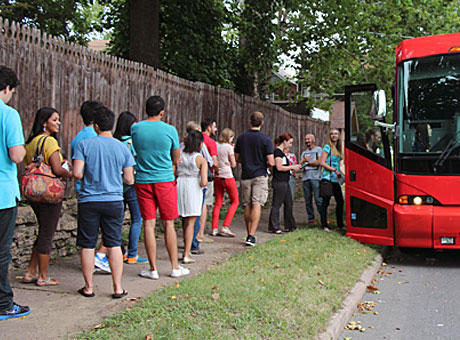
First-year medical students board a tour bus in St. Louis as part of the Washington University Medical Plunge. The group was taken on a tour of central and north St. Louis led by Bob Hansman, associate professor of architecture and artist-in-residence in the Sam Fox School of Design & Visual Arts at Washington University.
BY Allison Braun
What began several years ago as an opportunity for students to volunteer has evolved into a weeklong crash course in public health, diversity and health-care disparities in St. Louis for first-year medical students at Washington University School of Medicine. The popular, optional program for incoming medical students has been such a success that it will be a requirement for all new medical students in 2014.
The program, named Washington University Medical Plunge, or WUMP, was created by Will Ross, MD, associate dean of diversity for the School of Medicine. WUMP was born out of Ross’ realization in the mid-1990s that even though students were working with the underprivileged at a neighborhood health clinic he started, they were only seeing the patients in a clinical setting. He wanted the students to understand the environments from which the patients came. So in 1999, he started WUMP.
Immersion program takes students out of the clinic and into the home neighborhoods of their potential patients.
“My goal is to get students to think more holistically, more broadly, about how to address the health of a community,” Ross said. “And the way to do that is to go see what ails the community, not just what the patient brings to the patient-care setting. I want them to feel confident in understanding community-based health and feel that they can be part of the solution to resolving health disparities locally, nationally, worldwide.”
This year’s incoming medical students saw struggling neighborhoods in central and north St. Louis on their first day of WUMP, during a bus tour led by Bob Hansman, associate professor of architecture at Washington University.
“When you go into the community, you learn things you didn’t know you were going to learn,” Hansman told the students. “You simply have to go there.”
While Hansman made clear the residents’ struggles over the decades, he also spoke fondly of the neighborhoods’ people, history and beauty amid the dilapidation. “These are my favorite neighborhoods,” he said.
Wilbur Song, a St. Louis County resident and first-year medical student, said he was glad he went on the tour and was surprised and moved by what he learned. “I didn’t know how bad it really was,” he said. Several others shared his feelings upon learning about the challenges that residents face in the city’s less affluent neighborhoods.
In addition to the tour, WUMP participants attended presentations by students, faculty and other health-care professionals; representatives from nonprofit organizations; and Elisabeth Askin and Nathan Moore, MD, who as Washington University medical students co-authored The Health Care Handbook: A Clear and Concise Guide to the United States Health Care System.
Ally Schelble, a first-year medical student from Milwaukee, was grateful for the inspirational stories the speakers shared, especially after the emotional bus tour with Hansman. “You think ‘How could I ever help these people enough that it would impact their lives?’” asked Schelble. “But then you see people like Dr. Rottnek, who is so passionate about what he does and really seems like he makes such a big difference as one person.” Fred Rottnek, MD, is the medical director and chief physician for corrections medicine for St. Louis County. Rottnek was one of the many inspirational presenters that students met during WUMP.
During the afternoons, students visited Grace Hill Murphy-O’Fallon Health Center; St. Louis Crisis Nursery; Epworth Children & Family Services, which helps children overcome severe emotional and behavioral challenges caused by abuse or neglect; Planned Parenthood of the St. Louis Region and Southwest Missouri; Gateway 180, a 24-hour emergency housing organization; the Missouri Department of Social Services; Family Partners Adult Day Services; Cancer Support Community of Greater St. Louis, which offers services to cancer patients, survivors and their loved ones; the St. Louis County Jail; Covenant House, which helps homeless, runaway and at-risk youth; and The Women’s Safe House.
Students learned what each organization does and how they can volunteer over the next four years. Most site visits included a service project, such as sorting books for Gateway 180’s family reading nights, or preparing classroom materials at Epworth.
“I want students to realize that irrespective of where they go in medicine – if they become physician scientists, specialists like me or primary-care providers – that they have to be instruments of change, that we all are responsible for the health of the community,” Ross said. “You can claim that you’re in a laboratory doing scientific work and that these issues don’t affect you, but we’re all invested in the health of our society, we’re all responsible.
“In their private lives, in their professional lives, they will have a continued commitment to improve the health of the community – that’s what I really want.”
Visit the Washington University School of Medicine in St. Louis Facebook page for photos taken throughout WUMP week.







